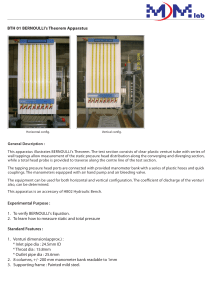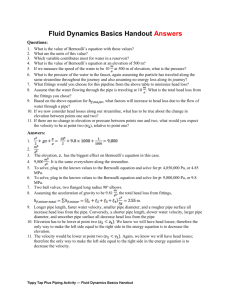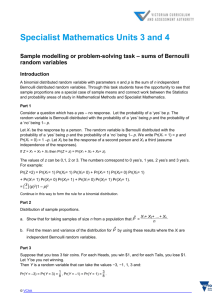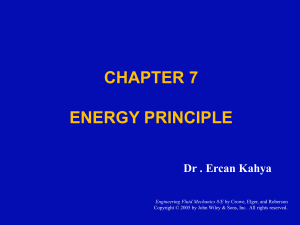Bernoulli's Equation: Energy Conservation in Fluid Mechanics
advertisement
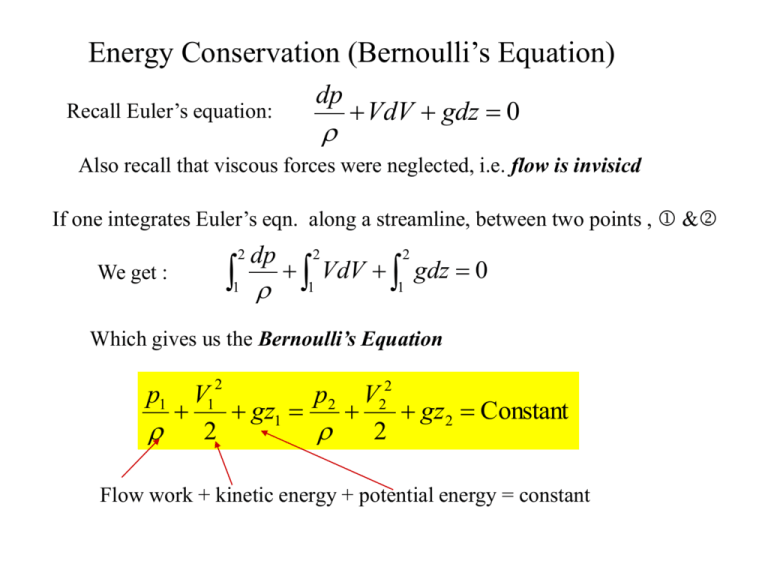
Energy Conservation (Bernoulli’s Equation) dp Recall Euler’s equation: VdV gdz 0 Also recall that viscous forces were neglected, i.e. flow is invisicd If one integrates Euler’s eqn. along a streamline, between two points , & We get : 2 1 dp 2 2 VdV gdz 0 1 1 Which gives us the Bernoulli’s Equation 2 V1 p2 V22 gz1 gz2 Constant 2 2 p1 Flow work + kinetic energy + potential energy = constant Bernoulli’s Equation (Continued) Flow Work (p/) : It is the work required to move fluid across the control volume boundaries. Consider a fluid element of cross-sectional area A with pressure p acting on the control surface as shown. p Dx A Due to the fluid pressure, the fluid element moves a distance Dx within time Dt. Hence, the work done per unit time DW/Dt (flow power) is: p DW pADx p Dx A AV , Dt Dt Dt 1 DW AV Dt p Flow work or Power Flow work per unit mass p pv 1/mass flow rate Flow work is often also referred to as flow energy Bernoulli’s Equation (Cont) Very Important: Bernoulli’s equation is only valid for : incompressible fluids, steady flow along a streamline, no energy loss due to friction, no heat transfer. 2 V1 p2 V22 z1 z2 , where g (energy per unit weigh t) 2g 2g p1 Application of Bernoulli’s equation - Example 1: Determine the velocity and mass flow rate of efflux from the circular hole (0.1 m dia.) at the bottom of the water tank (at this instant). The tank is open to the atmosphere and H=4 m p1 = p2, V1=0 1 V2 2 g ( z1 z 2 ) 2 gH H 2 * 9.8 * 4 8.85 (m / s ) m AV 1000 * 2 69.5 (kg / s ) 4 (0.1) 2 (8.85) Bernoulli’s Eqn/Energy Conservation (cont.) Example 2: If the tank has a cross-sectional area of 1 m2, estimate the time required to drain the tank to level 2. 1 First, choose the control volume as enclosed by the dotted line. Specify h=h(t) as the water level as a function of time. h(t) From Bernoulli' s equation, V = 2gh dm Ahole V dt Ahole dh (0.1)2 since m Atan k h, V 2 2 gh dt Atan k 1 From mass conservation, 2 water height (m) 4 4 3 dh 0.0443 h , dt h( t ) 2 2.5e-007 dh 0.0443dt, integrate h h(t) =0 H 0.0215t, h 0, tdrain 93 sec. 2 h - 0.0443t 1 4 0 0 0 20 40 60 t time (sec.) 80 100 100 t 90.3 sec Energy exchange (conservation) in a thermal system Energy added, hA (ex. pump, compressor) p2 p1 2 V2 z2 2g 2 V1 z1 2g Energy lost, hL (ex. friction, valve, expansion) Energy extracted, hE (ex. turbine, windmill) hL loss through valves heat exchanger hE hA turbine pump hL, friction loss through pipes condenser hL loss through elbows Energy conservation(cont.) If energy is added, removed or lost via pumps turbines, friction, etc.then we use 2 V1 p2 V22 Extended Bernoulli’s Equation z1 hA hE hL z2 2g 2g p1 Example: Determine the efficiency of the pump if the power input of the motor is measured to be 1.5 hp. It is known that the pump delivers 300 gal/min of water. No turbine work and frictional losses, hence: hE=hL=0. Also z1=z2 4-in dia.pipe 6-in dia. pipe 2 1 pump zo Z=15 in Given: Q=300 gal/min=0.667 ft3/s=AV V1= Q/A1=3.33 ft/s V2=Q/A2=7.54 ft/s kinetic energy head gain V22 V12 (7.54)2 (3.33)2 0.71 ft, 2g 2 * 32.2 Looking at the pressure term: p1 w zo m z p2 w zo w z Mercury (m=844.9 lb/ft3) water (w=62.4 lb/ft3) 1 hp=550 lb-ft/s p2 p1 ( m w )z (844.9 62.4) * 1.25 97813 . lb / ft 2 Energy conservation (cont.) Example (cont.) Pressure head gain: p2 p1 97813 . 15.67 ( ft ) w 62.4 pump work hA p2 p1 w V22 V12 16.38( ft ) 2g Flow power delivered by pump P = w QhA (62.4)(0.667)(16.38) 681.7( ft lb / s) 1hp 550 ft lb / s P 1.24 hp Efficiency = P Pinput 1.24 0.827 82.7% 1.5 Frictional losses in piping system 2 V1 p2 V22 Extended Bernoulli' s equation, z1 hA hE hL z2 2g 2g p1 p2 Dp hL frictional head loss p1 P1 P2 Consider a laminar, fully developed circular pipe flow R: radius, D: diameter L: pipe length w: wall shear stress [ p ( p dp)](R 2 ) w (2R)dx, w P+dp p Darcy’s Equation: ww Pressure force balances frictional force 2 dp w dx, integrate from 1 to 2 R Dp p1 p2 I F I F IF J HK HKG HK 44w w L L L LV 2 V hhLL f f gg D D D D2 g 2 g 2 f f VV22 where f is defined as frictional factor characterizing 44 22 pressure loss due to pipe wall shear stress I FIF G HK H J K When the pipe flow is laminar, it can be shown (not here) that f 64 VD , by recognizing that Re , as Reynolds number VD 64 , frictional factor is a function of the Reynolds number Re Similarly, for a turbulent flow, f = function of Reynolds number also Therefore, f f F(Re). Another parameter that influences the friction is the surface roughness as relativeto the pipe diameter D . I F Re, : Pipe frictional factor is a function of pipe Reynolds Such that ff FF Re, H D DK number and the relative roughness of pipe. This relation is sketched in the Moody diagram as shown in the following page. The diagram shows f as a function of the Reynolds number (Re), with a series of parametric curves related to the relative roughness FI. HDDK Losses in Pipe Flows Major Losses: due to friction, significant head loss is associated with the straight portions of pipe flows. This loss can be calculated using the Moody chart or Colebrook equation. 1 2.0 log D 2.51 , valid for nonlaminar range F G H3.7 f Re IJ fK Minor Losses: Additional components (valves, bends, tees, contractions, etc) in pipe flows also contribute to the total head loss of the system. Their contributions are generally termed minor losses. The head losses and pressure drops can be characterized by using the loss coefficient, hL Dp KL, which is defined as 2 1 K L 2 V / 2g 1 V 2 2 , so that Dp K V L 2 One of the example of minor losses is the entrance flow loss. A typical flow pattern for flow entering a sharp-edged entrance is shown in the following page. A vena contracta region is formed at the inlet because the fluid can not turn a sharp corner. Flow separation and associated viscous effects will tend to decrease the flow energy; the phenomenon is fairly complicated. To simplify the analysis, a head loss and the associated loss coefficient are used in the extended Bernoulli’s equation to take into consideration this effect as described in the next page. V Minor Loss through flow entrance 1 V2 V 3 p V 2 2 gz (1/2)V3 (1/2)V22 2 KL(1/2)V3 2 2 pp p3 V32 V32 V1 Extended Bernoulli' s Equation : z1 hL z3 , hL K L 2g 2g 2g p1 p1 p3 p , V1 0, V3 1 1 KL ( 2 g ( z1 z3 ) 2 gh 1 KL Energy Conservation (cont.) Let us now also account for energy transfer via Heat Transfer, e.g. in a heat exchanger The most general form of conservation of energy for a system can be written as: dE = dQ-dW where (Ch. 3, YAC) dE Change in Total Energy, E and E = U(internal energy)+Em(mechanical energy) E = U + KE (kinetic energy) + PE(potential energy) dW Work done by the system where W = Wext(external work) + Wflow(flow work) (Ch. 1 YAC) mechanical energy dQ = Heat transfer into the system (via conduction, convection & radiation) Convention: dQ > 0 net heat transfer into the system (Symbols Q,q..) dW > 0, positive work done by the system Q: What is Internal Energy ? Energy Conservation (cont.) U = mu, u(internal energy per unit mass), KE = (1/2)mV2 and PE = mgz Flow work Wflow= m (p/) It is common practice to combine the total energy with flow work. Thus: F I G J H K V2 pp Energy flow rate: m(u + gz ) plus Flow work rate m 2 V2 p V2 Flow energy in m in (u gz )in , Energy out = m out (u gz )out 2 2 p The difference between energy in and out is due to heat transfer (into or out) and work done (by or on) the system. Energy Conservation (cont.) Hence, a system exchanges energy with the environment due to: 1) Flow in/out 2) Heat Transfer, Q and 3) Work, W This energy exchange is governed by the First Law of Thermodynamics p 2 V m in (u gz)in 2 Heat in, Q =dQ/dt V2 m in (u gz )out 2 p system From mass conservation: m in m out m Work out dW/dt From the First law of Thermodynamics (Energy Conservation): dQ p V2 p V2 dW m(u gz )in m(u gz )out , or dt 2 2 dt dQ V2 V2 dW m( h gz )in m(h gz )out dt 2 2 dt p where h u is defined as "enthaply" “Enthalpy” Conservation of Energy – Application Example: Superheated water vapor enters a steam turbine at a mass flow rate 1 kg/s and exhausting as saturated steam as shown. Heat loss from the turbine is 10 kW under the following operating condition. Determine the turbine power output. 10 kw P=1.4 Mpa T=350 C V=80 m/s z=10 m From superheated vapor tables: hin=3149.5 kJ/kg dQ V2 V2 dW m (h gz )in m (h gz )out dt 2 2 dt dW ( 10) (1)[(3149.5 2748.7) dt 80 2 50 2 (9.8)(10 5) ] 2(1000) 1000 10 400.8 1.95 0.049 P=0.5 Mpa 100% saturated steam 392.8( kW ) V=50 m/s z=5 m From saturated steam tables: hout=2748.7 kJ/kg Q, q … ?!% Q – total heat transfer (J) Q – rate of total heat transfer (J/s, W) q – heat transfer per unit mass (J/kg) q – Heat Flux, heat transfer per unit area (J/m2) Back Internal Energy ? •Internal energy, U (total) or u (per unit mass) is the sum of all microscopic forms of energy. •It can be viewed as the sum of the kinetic and potential energies of the molecules • Due to the vibrational, translational and rotational energies of the moelcules. •Proportional to the temperature of the gas. Back
